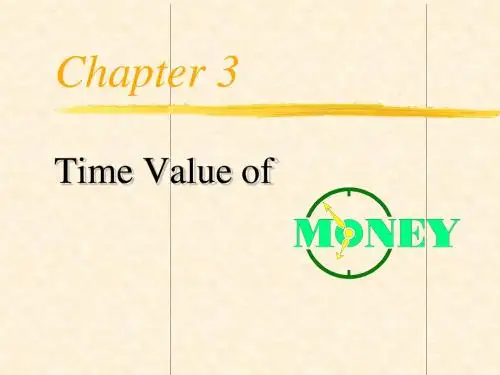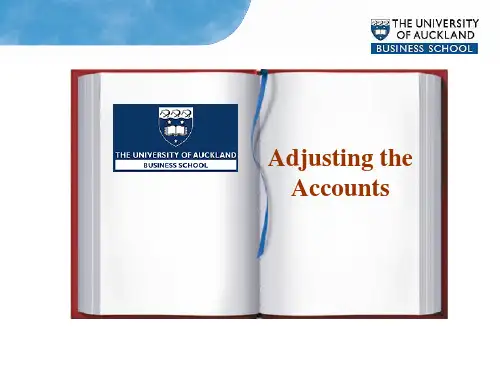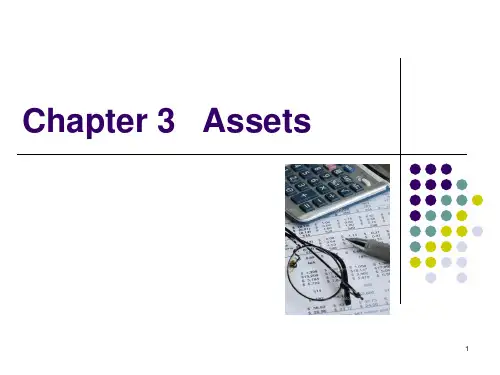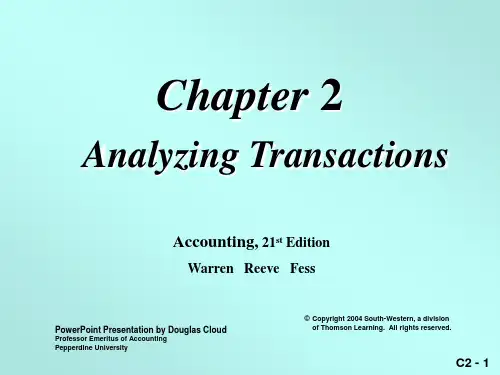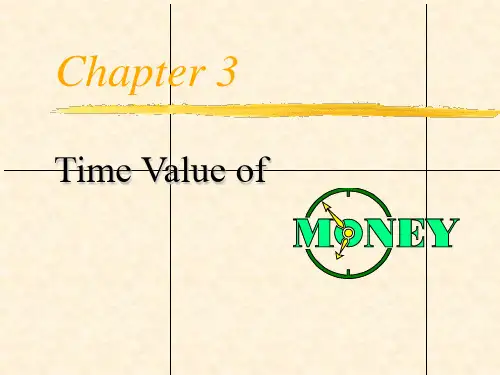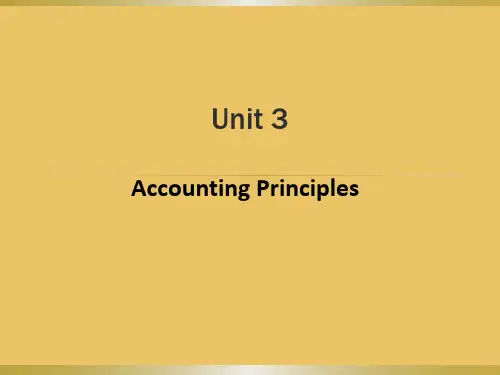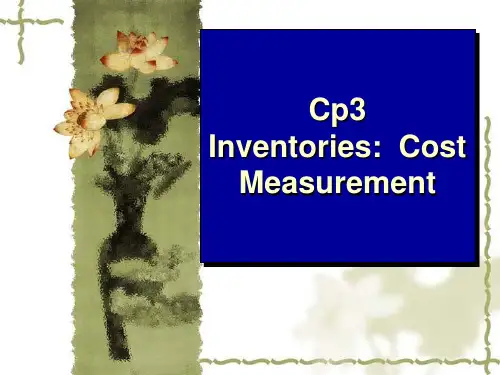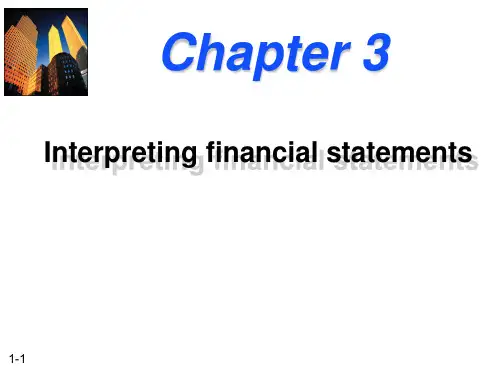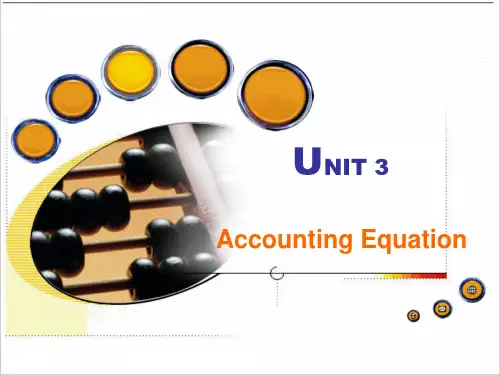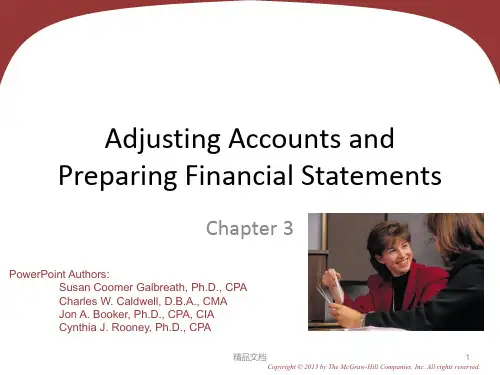- 1、下载文档前请自行甄别文档内容的完整性,平台不提供额外的编辑、内容补充、找答案等附加服务。
- 2、"仅部分预览"的文档,不可在线预览部分如存在完整性等问题,可反馈申请退款(可完整预览的文档不适用该条件!)。
- 3、如文档侵犯您的权益,请联系客服反馈,我们会尽快为您处理(人工客服工作时间:9:00-18:30)。
C2 - 15
To assist you in learning, an account can be drawn to resemble the letter T.
C2 - 16
The T-Account
Cash
The T-account has a title.
C2 - 17
The T-Account
C2 - 19
The T-Account
Cash
3,750 4,300 2,900 850 1,400 700 2,900
Typical entries
C2 - 20
Balancing a T-Account
C2 - 21
First, foot the debit side.
Cash
3,750 4,300 2,900 10,950 850 1,400 700 2,900
Chapter 2
Analyzing Transactions
Accounting, 21st Edition
Warren Reeve Fess
PowerPoint Presentation by Douglas Cloud
Professor Emeritus of Accounting Pepperdine University
C2 - 2
Objectives
1. Explain why accounts are used After studying this to record and summarize chapter, the effects of transactions on you should financial statements. be able to: 2. Describe the characteristics of an account. 3. List the rules of debit and credit and the normal balances of accounts. 4. Analyze and summarize the financial statement effects of transactions.
C2 - 13
Assets =Liabilitie + Owner's Equity • ----------- = --------+ ----------• + _ _ + _ + •
C2 - 14
OBJECTIVE 2 — the characteristics of an account.
C2 - 4
Objective 1:Usefulness of an Account
1)Accounts are used to record business transactions. 2)An account is simply a record of all the increases and decreases in a financial statement item (such as cash, supplies, and accounts payable). 3)A group of accounts is called a ledger.
C2 - 3
Objectives
5. Prepare a trial balance and explain how it can be used to discover errors. 6. Discover errors in recording transactions and correct them. 7. Use horizontal analysis to compare financial statements from different periods.
C2 - 10
Major Account Classifications
Assets are resources owned by the business. Cash Supplies Building Accounts receivable Liabilities are debts owed to outsiders (creditors). Accounts payable Notes payable Wages payable
Cash
Left side debit
The left side of the account is the debit side.
C2 - 18
The T-Account
Cash
Left side debit Right side credit
The right side of the account is the credit side.
© Copyright 2004 South-Western, a division of Thomson Learning. All rights reserved. Task Force Image Gallery clip art included in this electronic presentation is used with the permission of NVTech Inc.
C2 - 22
Cash
3,750 4,300 Next, foot the 2,900 credit side. 10,950 850 1,400 700 2,900 5,850
C2 - 23
5,100
4,300 2,900 10,950
Subtract total credits Cash from total debits to obtain the account 3,750 850 balance.
Major Account Classifications
C2 - 12
Major Account Classifications
Owner’s equity is the owner’s right to the assets of the business. Chris Clark, Capital Chris Clark, Drawing Revenues are increases in owner’s equity as a result of selling services or products. Fees Earned Fares Earned Commission Revenue Expenses are the using up of assets or consuming of services to generate revenue. Rent Expense Salary Expense Utilities Expense
C2 - 11
Liabilities are often identified sheetare by debts titles Assets are on the balance Liabilities . resources owned that include owed payable to outsiders by the business. (creditors). Cash Supplies Building Accounts receivable Accounts payable Notes payable Wages payable
C2 - 1
Some of the action has been automated, so click the mouse when you see this lightning bolt in the lower right-hand corner of the screen. You can point and click anywhere on the screen.
C2 - 7
A list of the accounts in a ledger is called a chart of accounts.
C2 - 8
1)Only a very small enterprise with very few transactions (such as a Internet Bar run by students) could use the accounting system illustrated in Chapter 1. Example:shop of school 2)For most businesses, this system would be inefficient. For example, in the prior chapter all business transactions affecting owner’s equity were recorded in the capital account. Chapter 2 :in the following accounts: capital, drawing, revenue, and expense accounts.
C2 - 9
• Under the text’s indexing system, accounts are assigned a two-digit number. The first digit indicates the account’s classification (1=assets, 2=liabilities, 3=owner’s equity, 4=revenue, and 5=expenses.)
• • • • • • • • • Dr. ___________cash________________Cr. 3,750 850 4,300 1,400 2,900 700 -------------------2,900 10,950 1,000 (total debits) ------------6,850(total credits) 10950-6850=4100(balance of account)
